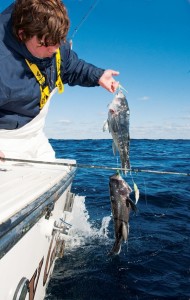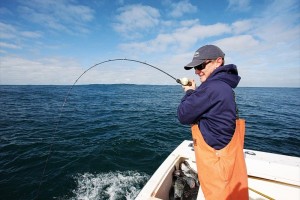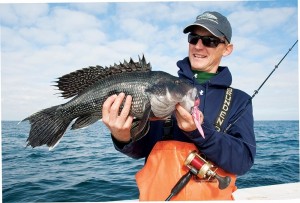Virginia Anglers Dig Deep for Big Black Sea Bass
By Ric Burnley
Published in Sport Fishing Magazine: http://www.sportfishingmag.com/species/fish-species/virginia-anglers-dig-deep-big-black-sea-bass?image=158887
When you’re 50 miles off Virginia Beach in the middle of winter, you hope the sea bass will be biting — otherwise, you’re in for a long, cold day. So, when the first two wrecks we fished offered only a few decent sea bass, I pulled my hat down and buttoned up my slicks. Then my buddy, Ken Neill, motored his 32 Albemarle over a sunken cargo ship in 200 feet of water, and huge red blobs appeared on the fish finder.
The air temperature sat just below freezing, and the wind whistled across the deck. My purple fingers struggled to flip the line release on my reel. As the braid spun off my spool, my teeth chattered; the two-hook bottom rig with its chunks of squid descended to the bottom.
Once the 8-ounce sinker hit bottom, I engaged the reel and turned the handle to tighten the line. Boom, boom, boom — the line violently jerked my rod tip. I lifted the rod, cranked quickly and set the hook. But I didn’t reel. I waited.
Boom, boom, boom — another fish took the second bait. With two sea bass yanking and jerking my line, I struggled to turn the handle and bring in my catch.
After a few minutes of steady cranking, two thick sea bass came up through the clear blue water. When the fish broke the surface, I reached down, took a wrap on the line, and swung my writhing prize over the gunwale. My buddies were too busy hunched over and cranking in their own fish to -congratulate me on my impressive sea bass.
These Northern relatives of the grouper usually weigh a couple of pounds, but both of my fish pushed the 5-pound mark. I looked in awe at their amazing colors — black scales flecked with iridescent purple and green. A big black hump grew out of each fish’s forehead; I could understand why big bass are called knotheads. These were trophy sea bass. As my friends pulled fish over the rail, I realized there were a lot of behemoths below the boat.
Each drop produced another brace of big sea bass. Steadily cranking the reel, unhooking fish, rebaiting and redropping had me heated. After a few more rounds, I stripped down to a sweatshirt and ball cap. This was hot sea bassin’!
Seasonal Sea Bass
While anglers find sea bass all year off Virginia Beach, the best fishing falls during the coldest weather. “These are some of the biggest sea bass I’ve ever seen,” Neill said, as the fish box started to fill, “and there are a lot of them.”
According to Neill, a six-time Virginia Master Angler, during the dead of winter between December and February, the fish congregate on wrecks in 120 to 300 feet of water that lie 40 to 50 miles offshore. The siren call of big sea bass will lure anglers far offshore where bad weather and cold water can make fishing tough. As spring moves in, Neill catches big sea bass while he’s drifting for blueline tilefish along the 50-fathom curve. “I slowly drive around searching the bottom with a fish finder until I mark a school of fish,” he says. In addition to catching sea bass, he’ll find the blueline tiles, big bluefish, and even grouper and wreckfish.
By summer, the fish spread out on inshore structure and reefs. “You can catch keeper sea bass (-12½-inch minimum size) on wrecks in 50 to 80 feet of water,” Neill says, “but you have to weed through a lot of throwbacks.”
In September, as water -temperatures drop, sea bass fishing improves. The action starts on reefs within 20 miles of shore and gets better as the fish migrate to deeper water. By November, the fish are thick on wrecks in 100 feet of water within 30 miles of the beach. “You can catch a limit of nice-size sea bass (15- or 20-fish daily bag last year, depending on the season and location) along with big bluefish and flounder,” Neill adds.
By the end of the year, the biggest sea bass have moved to the deepest wrecks. With so many wrecks and reefs off the Virginia coast, anglers can plan their strategy based on wind direction. “Start the day running up-sea so you have a following sea on the way home,” Neill suggests. If the fish don’t bite, the current is too strong or the dog sharks are too thick, then Neill moves to another wreck.
“I’ll head inshore or offshore, north or south, each piece will have a different scenario,” he explains. “Conditions can be completely different on wrecks that are only a few miles apart.”
Location, Location, Location
When it comes to finding sea bass, not only does the skipper have to locate the right wreck, but then he also has to pinpoint the fish. At each wreck we visited during our winter trip, Neill would first make a circle around the structure while watching his electronics. “Sometimes the fish can be 100 yards off the mark,” he explained. After a couple of laps, he took the boat out of gear and gave the thumbs up.
The best way to test the waters is to make a drop. Neill used the engines to hold the boat over the wreck while our lines raced to the bottom. “I position the boat so the lines are straight up and down,” he says. “When the line starts to streak away from the boat, I bump the engine into gear and motor toward the line.” Keeping the lines straight also prevents anglers from tangling rigs or getting snagged in the wreck.
When we started catching one fish after another, Neill decided to deploy the anchor. He uses a heavy grapple hook made out of bent rebar, attached to an 8-foot length of chain. With one crew member holding the anchor rode and another ready with the ground tackle, Neill moved the boat up-current of the wreck. When he had motored 50 yards above the site, he instructed the angler to drop the hook. When the anchor hit bottom, Neill let the boat drift back to the wreck until the line came tight. The anglers adjusted the rode until the boat was directly over the marks. “Time to go to work,” Neill told us.
Endgame
The classic sea bass terminal tackle involves a two-hook dropper rig tied into 50-pound monofilament. Start with 4 feet of mono leader. Tie a surgeon’s loop at the bottom of the leader and two dropper loops a foot apart in the middle.
Loop a pair of 5/0 bait-holder hooks to each dropper, and bait up with cut squid. Add an 8- to 12-ounce sinker to the surgeon’s loop and tie a 150-pound, ball-bearing swivel to the top end of the rig.
To bling out their baits, Neill’s crew added a bucktail skirt or little rubber squid — usually red or chartreuse — above the hooks. “It gives the bait more profile and keeps the hooks floating so they don’t get tangled on the main line,” he says.
The first 5-pounder to hit the box inspired several guys to change out their rigs for jigs. “The bait rigs get eaten so fast by smaller fish, a metal jig might last long enough to get hit by a bigger sea bass,” Neill explains.
The crew had armed itself with 6- to 7-foot, heavy-action boat rods. To quickly drop a bait and retrieve a fish from the bottom, anglers prefer high-speed, single-speed conventional reels capable of gathering at least 36 inches of line with a single turn of the handle, such as Shimano Torium 30s.
We had filled the reels with 60-pound braid, which allows the angler to feel every bump of the bottom and every tap from a sea bass. To protect the braid from rubbing against the structure, each angler attached a 10-foot shock leader of 80-pound, -abrasion‑resistant monofilament to a foot of doubled main line with a no-name knot. That shock leader was then tied to the 150-pound ball-bearing swivel and double-loop rig, or attached directly to a jig with a uni-knot.
Our crew used a variety of metal from butterfly to diamond jigs. While it took 10 ounces of lead to sink our bait rigs to the bottom, it took only a 5-ounce jig to drop to the wreck. Not only did the jigs produce bigger fish, but they also were easier to retrieve, which caused less fatigue after a long day of cranking in fish. The jigs don’t require bait either, which saves time between drops and ultimately results in more-productive fishing.
Trophy Hunting
To test the theory that artificial lures might catch bigger sea bass, I pulled out my Shimano Lucanus jigging system, which consists of a 6-foot, medium-heavy Tescata rod and 400 Calcutta D reel, spooled with 30-pound PowerPro and punctuated with a 10-foot shock leader of 50-pound fluorocarbon. I tied the fluoro directly to a 7-ounce Lucanus jig with a uni-knot, and then dropped it into the water.
While my buddies wildly bounced their jigs off the bottom, I slowly turned the handle on my reel to steadily bring my Lucanus jig off the wreck. It took only a few cranks before the line transmitted the tap-tap-tap of a sea bass on the jig. I kept cranking slowly. The fish kept tap-tap-tapping. When I felt the bite, I quickened my cranking and wrestled my sea bass to the surface.
The lighter rod and smaller reel -definitely put more sport into this fishing. A 5-pounder bucked hard and took line all the way to the boat.
The size and shape of our lures didn’t matter; these sea bass were hungry. Using the jigs, the crew continued to pull in bass that were indeed markedly bigger than those caught on bait. The biggest fish of the day — a knotheaded 7-pounder — was caught on a blue-and-white Stingsilver. My Lucanus jig attracted steady action on big fish, producing my personal best: a stubborn 6½-pounder.
With a limit of trophy sea bass, and plenty of daylight left in the short winter day, we headed back to Rudee Inlet. I was tired and a little sore, but I definitely was not cold.
About the Author: When Ric Burnley isn’t frozen, baked, wind blown or soaking wet, he’s a high school English teacher in Virginia Beach, Virginia, and a regular contributor to Sport Fishing.
Sea Bass Battles
For mid-Atlantic anglers, sea bass management is a Catch-22. On one hand, tough regulations for the past several years have resulted in epic sea bass fishing today. On the other hand, conservative catch quotas are keeping anglers from enjoying the largess.
“Sea bass fishing is so good that I’m not allowed to catch them,” complains Capt. Skip Feller, of the Virginia Beach headboat Rudee Angler, and a sea bass advisory council member for the Atlantic States Marine Fisheries Commission and the Mid-Atlantic Fishery Management Council. “Sea bass are not overfished, experiencing overfishing, or in danger of overfishing.”
Feller claims that the problem lies in the coastwide management of sea bass. Since the fish occur in state and federal waters, both sides set regulations. However, once federal quotas are met, the fishery is shut down. Last fall, this conundrum caused the cancellation of the fall season from Nov. 1 to Dec. 31. “All summer, anglers up north catch sea bass and deplete the quota,” he explains, “then when the fishing gets good off Virginia, the quota is filled and the federal government closes the season.”
Toni Kerns, the ASMFC’s Interstate Fisheries Management program director, is looking for a compromise. “We’ve introduced addendums that allowed Southern states a smaller size limit, and we reopened the season at the beginning of the year to allow their anglers additional opportunity to harvest sea bass.” In addition, the ASMFC is working to give individual states more control over their seasons and regulations. “We are trying to craft regulations that allow anglers to take advantage of the fishery without overfishing the fish,” she says.
That’s something sea bass anglers, like Feller, would welcome. “Sea bass fishing is better than ever,” he says, “I wish we could go out and catch them.”
——————————————————————————–
Sea Bass Time
Sea bass season (which ran Jan. 1 to Feb. 28, May 19 to Oct. 14 and Nov. 1 to Dec. 31 in 2013) ramps up in late summer on midshore reefs in 60 to 100 feet of water, like the Tower Reef, 13 miles off Virginia Beach’s Rudee Inlet. By November and December, the fish move to structure in 120 to 200 feet of water. Triangle Reef, 30 miles east of Virginia Beach, holds big sea bass, flounder and chopper bluefish.
In the dead of winter, big sea bass hold on deepwater wrecks 50 miles offshore. When the season opens in spring, it’s a good time to catch knotheaded sea bass mixed with blueline tiles, grouper and wreckfish on the 50-fathom curve along Norfolk Canyon.
For a list of wrecks and reefs, go to the Virginia Artificial Reef Program website. For up-to-date season and bag limits, go to noaa.gov.
——————————————————————————–
Virginia Beach Sea Bass Charters
Capt. Fred Feller
Rudee Angler
757-425-3400
rudeeinletcharters.com
Capt. Jake Hiles
Matador Sportfishing
757-749-6008
matadorcharters.com
Capt. Steve Wray
Ocean Pearl
757-237-7517
vbsf-hookedup.net/oceanpearl




